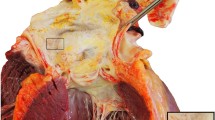Abstract
The development of a diffuse elastic tissue defect resembling pseudoxanthoma elasticum (PXE) is a recently established and frequently encountered clinical entity in β-thalassemia. The clinical spectrum of this disorder is not yet completely understood as it is continuously being enriched with novel complications that are often serious. We present here a thalassemia intermedia patient with typical PXE manifestations and a fusiform aneurysmatic dilatation of the ascending thoracic aorta, a previously unknown complication in these patients. An aortic aneurysm has itself a notable morbidity, while it may also impair the particularly susceptible cardiac function of β-thalassemia patients, hence affecting the overall prognosis of the main disease.



Similar content being viewed by others
References
Aessopos A, Farmakis D, Loukopoulos D (2002) Elastic tissue abnormalities resembling pseudoxanthoma elasticum in beta thalassemia and the sickling syndromes. Blood 99:30–35
Aessopos A, Farmakis D, Loukopoulos D (2002) Elastic tissue abnormalities in inherited haemolytic syndromes. Eur J Clin Invest 32:640–642
Johnston KW, Rutherford RB, Tilson MD, Shah DM, Hollier L, Stanley JC (1991) Suggested standards for reporting on arterial aneurysms. Subcommittee on Reporting Standards for Arterial Aneurysms, Ad Hoc Committee on Reporting Standards, Society for Vascular Surgery and North American Chapter, International Society for Cardiovascular Surgery. J Vasc Surg 13:452–458
Isselbacher EM (2001) Diseases of the aorta. In: Braunwald E (ed) Heart disease, 6th edn. W.B. Saunders, Philadelphia, pp 1422–1431
Pyeritz RE, McKusick VA (1979) The Marfan syndrome: diagnosis and management. N Engl J Med 300:772–777
Holmes DR, Liao S, Parks WC, Thompson RW (1995) Medial neovascularization in abdominal aortic aneurysms: a histopathologic marker of aneurysmal degeneration with pathophysiologic implications. J Vasc Surg 21:761–771
Reilly JM, Brophy CM, Tilson MD (1992) Characterization of an elastase from aneurysmal aorta which degrades intact aortic elastin. Ann Vasc Surg 6:499–502
Neldner KH (1988) Pseudoxanthoma elasticum. Clin Dermatol 6:1–159
Baccarani-Contri M, Bacchelli B, Boraldi F, Quaglino D, Taparelli F, Carnevali E, Francomano MA, Seidenari S, Bettoli V, De Sanctis V, Pasquali-Ronchetti I (2001) Characterization of pseudoxanthoma elasticum-like lesions in the skin of patients with beta-thalassemia. J Am Acad Dermatol 44:33–39
Tsomi K, Karagiorga-Lagana M, Fragodimitri C, Karabatsos F, Katsiki V (1999) Arterial elastorrhexis: manifestation of a generalized elastic tissue disorder in beta-thalassaemia major. Eur J Haematol 63:287–294
Aessopos A, Samarkos M, Voskaridou E, Papaioannou D, Tsironi M, Kavouklis E, Vaiopoulos G, Stamatelos G, Loukopoulos D (1998) Arterial calcifications in beta-thalassemia. Angiology 49:137–143
Thierry A, Ballivet J, Dumas R, Binnert D, Nivelon A, Foissac JC, Faure R (1972) Familial cases of intracranial aneurysms. Review of the literature and case report (in French). Neurochirurgie 18:267–276
Heno P, Fourcade L, Duc HN, Bonello R, Roux O, Van de Walle JP, Mafart B, Touze JE (1998) Aorto-coronary dysplasia and pseudoxanthoma elasticum (in French). Arch Mal Coeur Vaiss 91:415–418
van den Berg JS, Hennekam RC, Cruysberg JR, Steijlen PM, Swart J, Tijmes N, Limburg M (2000) Prevalence of symptomatic intracranial aneurysm and ischaemic stroke in pseudoxanthoma elasticum. Cerebrovasc Dis 10:315–319
Bendjelid K (1999) Pseudoxanthoma elasticum and coronary aneurysm (in French). Arch Mal Coeur Vaiss 92:373–374
Munyer TP, Margulis AR (1981) Pseudoxanthoma elasticum with internal carotid artery aneurysm. AJR Am J Roentgenol 136:1023–1024
Kito K, Kobayashi N, Mori N, Kohno H (1983) Ruptured aneurysm of the anterior spinal artery associated with pseudoxanthoma elasticum. Case report. J Neurosurg 58:126–128
Cianciulli P, Sorrentino F, Maffei L, Amadori S, Cappabianca MP, Foglietta E, Carnevali E, Pasquali-Ronchetti I (2002) Cardiovascular involvement in thalassaemic patients with pseudoxanthoma elasticum-like skin lesions: a long-term follow-up study. Eur J Clin Invest 32:700–706
Jeremy RW, Huang H, Hwa J, McCarron H, Hughes CF, Richards JG (1994) Relation between age, arterial distensibility, and aortic dilatation in the Marfan syndrome. Am J Cardiol 74:369–373
Cheung YF, Chan GC, Ha SY (2002) Arterial stiffness and endothelial function in patients with beta-thalassemia major. Circulation 106:2561–2566
Aessopos A, Farmakis D, Karagiorga M, Voskaridou E, Loutradi A, Hatziliami A, Joussef J, Rombos J, Loukopoulos D (2001) Cardiac involvement in thalassemia intermedia: a multicenter study. Blood 97:3411–3416
Aessopos A, Farmakis D, Karagiorga M, Rombos I, Loucopoulos D (1997) Pseudoxanthoma elasticum lesions and cardiac complications as contributing factors for strokes in beta-thalassemia patients. Stroke 28:2421–2424
Farmakis D, Moyssakis I, Perakis A, Rombos Y, Deftereos S, Giakoumis A, Polymeropoulos E, Aessopos A (2003) Unstable angina associated with coronary arterial calcification in a thalassemia intermedia patient with a pseudoxanthoma elasticum-like syndrome. Eur J Haematol 70:64–66
Zurlo MG, De Stefano P, Borgna-Pignatti C, Di Palma A, Piga A, Melevendi C, Di Gregorio F, Burattini MG, Terzoli S (1989) Survival and causes of death in thalassaemia major. Lancet 2:27–30
Author information
Authors and Affiliations
Corresponding author
Rights and permissions
About this article
Cite this article
Farmakis, D., Vesleme, V., Papadogianni, A. et al. Aneurysmatic dilatation of ascending aorta in a patient with β-thalassemia and a pseudoxanthoma elasticum-like syndrome. Ann Hematol 83, 596–599 (2004). https://doi.org/10.1007/s00277-004-0859-6
Received:
Accepted:
Published:
Issue Date:
DOI: https://doi.org/10.1007/s00277-004-0859-6




